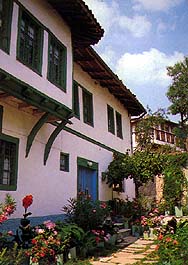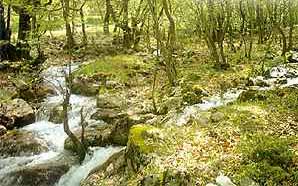|
|
Kozani
 Kozani, a picturesque town set 710 metres above sea level, is the
prefectural capital. The name Kozani originated from Kozani, a
city in Epirus, where the settlers, who were agriculturists
and cattle - breeders, came from after the battle of
Kossyfopedio. Archaeological excavations have revealed that an
ancient city existed on the place where Kozani lies today up
to the time of the Roman occupation.
Kozani, a picturesque town set 710 metres above sea level, is the
prefectural capital. The name Kozani originated from Kozani, a
city in Epirus, where the settlers, who were agriculturists
and cattle - breeders, came from after the battle of
Kossyfopedio. Archaeological excavations have revealed that an
ancient city existed on the place where Kozani lies today up
to the time of the Roman occupation.
The town has
several interesting churches, some with beautifully carved
icon-screens, some with lovely frescoes, as well as a few 19th
century mansion houses. Kozani's pride and glory is the
Kouventarios Municipal Library, which contains 69.000 volumes
and a large number of manuscripts. Also worth a visit is the
Analipsi Monastery, a bit to the north of town, where the
weavings, rugs and embroideries made by the nuns have won
considerable renown.
The
Historical - Folklore Museum and the Museum of Natural History
of Kozani is the creation of the Letters and Arts Association.
The Association was established in 1968 in the capital of
homonymous county, Kozani, with the view to
(collecting, recording, preserving, studying and publishing
linguistic, historical, archaeological and
folklore matter and preserving the monuments of our cultural
heritage) and also with the view to (collecting every
element that gives information about the composition of the
soil and the gradual development of the world, planets and
animals).
 Those
wishing a more traditional atmosphere will want to go to
Siatista (28 km. to the southwest) on the slopes of Mt.
Siniatsikos (alt. 920 m.). Thanks to its fur industry, the
town prospered in terms of both commerce and culture in the
18th and 19th century, and the churches, schools and mansions
built during that era still stand. The interiors of Siatista's
houses are beautifully decorated with carved wooden ceilings,
stained glass windows and elegant fireplaces. Those
wishing a more traditional atmosphere will want to go to
Siatista (28 km. to the southwest) on the slopes of Mt.
Siniatsikos (alt. 920 m.). Thanks to its fur industry, the
town prospered in terms of both commerce and culture in the
18th and 19th century, and the churches, schools and mansions
built during that era still stand. The interiors of Siatista's
houses are beautifully decorated with carved wooden ceilings,
stained glass windows and elegant fireplaces.
The market
town of Velvendos lies 30 kilometres southeast of Kozani.
Surrounded by plane and poplar woods, peach orchards and
hazelnut stands near the Aliak-mon river, it too has retained
many of its old mansions. In addition, many new buildings are
designed in the traditional style.
Other
villages where old Macedonian architecture can be seen and
admired are Pentalofos, Katafigi, Vlasti and Tsotili with a
picturesque arched bridge.
Servia
controls the pass over the mountains to Thessaly; here there
is both a Byzantine fortress and several Byzantine churches
with superb frescoes.
Finally, at
Perdikas, near the town of Ptolemaida, the anthropologist Aris
Poulianos discovered the bones of a prehistoric elephant. One
of the oldest specimens of the kind ever found in Europe, it
lived in the region some three million years ago.
|
>> Macedonia :
Drama,
Florina,
Grevena,
Halkidiki,
Imathia,
Kastoria,
Kavala,
Kilkis,
Kozani,
Pella,
Pieria,
Serres,
Thassos Island,
Thessaloniki.
|
|